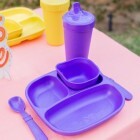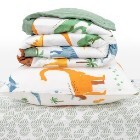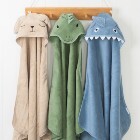2. Merino is useable year round
Merino isn’t just for the cold winter months. It’s so fine and light, that it can be used in summer as well! The natural crimp of a Merino fibre enables it to trap air effectively, thus insulating the body from the cold.
Even when air is cold or damp, a molecular process called 'heat of sorption' releases heat, which can be felt by the garment wearer. All fibres do this, but Merino does it four times as much as nylon and at least double this for polyester.
Its ability to wick moisture away from the skin means it’s a great alternative to cotton as it doesn’t get all clammy and damp. Much better for when you’re trying to keep baby cool at the start of a hot summer night!
If baby sleeps in a lightweight merino sleeping bag during summer, they may only need a nappy on underneath. In winter, you can layer your baby in layers of merino under a sleeping bag or sleep suit to ensure they are toasty warm.























